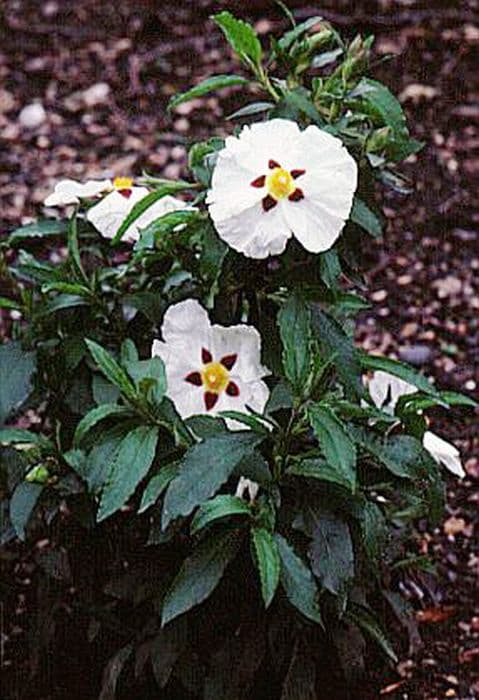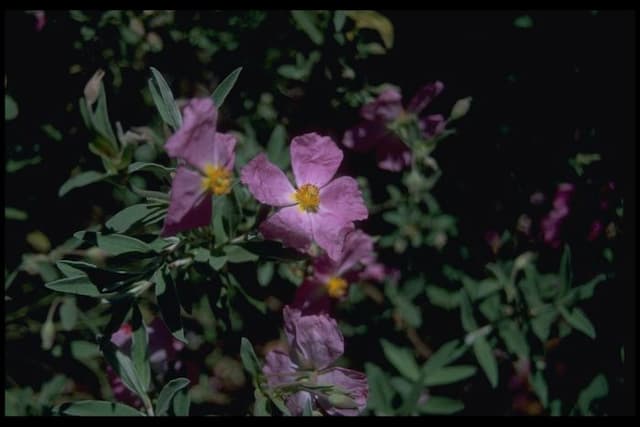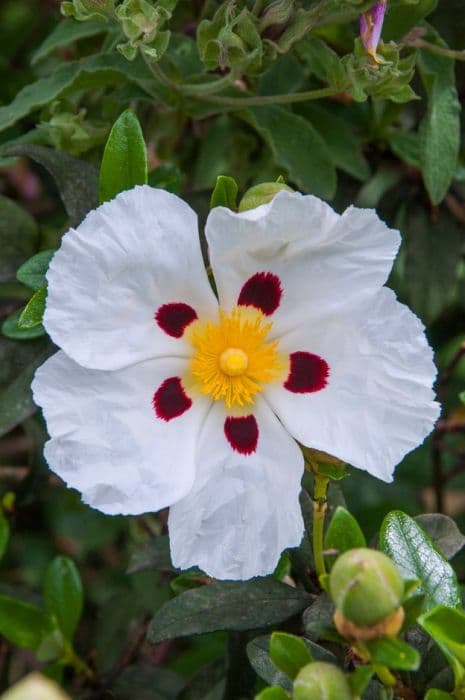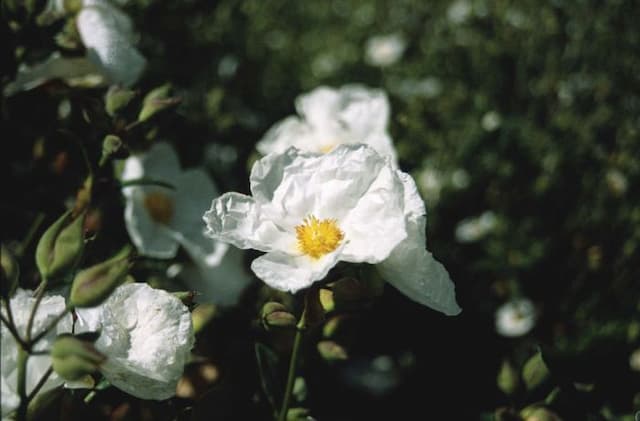Gum rockrose Cistus ladanifer L.

ABOUT
Cistus ladanifer L., commonly known as gum rockrose, is a distinctive shrub known for its striking appearance. This plant boasts large, showy white flowers that typically have a conspicuous maroon spot at the base of each petal, creating a visual contrast that's both bold and beautiful. The flowers are composed of five petals, which give them a simple yet elegant shape, resembling crepe paper in their texture. The gum rockrose has a dense, bushy form, and its leaves are unique in their own right. The leaves are lance-shaped and possess a dark green color with a glossy surface. A notable feature of the foliage is its aromatic quality, releasing a pleasant fragrance especially when warmed by the sun. This scent comes from the sticky, resinous substance that coats the leaves, which not only contributes to the plant's distinct smell but also adds a slightly shiny appearance to the foliage. Completing the overall appearance of the gum rockrose are its stems, which are woody and provide a strong structure for the shrub. The intertwining stems and the evergreen nature of the leaves contribute to the plant maintaining a robust and full-bodied look throughout the year. Overall, the gum rockrose is quite a magnificent sight when in full bloom, with its attractive flowers and resinous, aromatic leaves capturing the attention of onlookers.
About this plant
 Names
NamesSynonyms
Gum Rockrose, Labdanum, Common Gum Cistus, Crimson-Spot Rockrose, Ladanum Cistus.
Common names
Cistus ladaniferus L., Cistus ladanum L., Cistus populifolius var. major Demoly, Cistus palhinhae P.Silva & Teles, Ledonia ladanifer (L.) O.Bolòs & J.Vigo.
 Toxicity
ToxicityTo humans
The plant commonly known as Gum Cistus is not widely recognized for being toxic to humans. There are no well-documented cases or significant research findings that indicate the ingestion of Gum Cistus causes toxicity in humans. However, as with many plants, it is possible that some individuals may experience allergic reactions or mild irritation when handling the plant or ingesting it, due to individual sensitivities. If one suspects poisoning or experiences adverse symptoms after contact with this plant, it is recommended to consult a healthcare professional.
To pets
Gum Cistus is not typically listed among plants that are toxic to pets. There are no significant reports or studies that indicate this plant poses a serious risk if ingested by animals such as cats and dogs. However, as with any non-food plant, consumption of large quantities may lead to gastrointestinal upset in some pets, with symptoms like vomiting or diarrhea. Should a pet exhibit adverse effects after ingesting parts of the Gum Cistus, it is advisable to contact a veterinarian.
 Characteristics
CharacteristicsLife cycle
Perennials
Foliage type
Evergreen
Color of leaves
Green
Flower color
White
Height
3-9 feet (0.91-2.74 meters)
Spread
4-10 feet (1.22-3.05 meters)
Plant type
Shrub
Hardiness zones
8
Native area
Mediterranean
Benefits
 General Benefits
General Benefits- Erosion control: Cistus ladanifer, commonly known as gum rockrose, is often used in landscaping to prevent soil erosion due to its extensive root system.
- Drought resistance: Gum rockrose is highly adaptive to dry environments, making it suitable for xeriscaping in areas with water scarcity.
- Low maintenance: This plant requires minimal care once established, making it ideal for gardeners looking for low-maintenance options.
- Wildlife habitat: It provides shelter and food for various insects and birds, enhancing local biodiversity.
- Ornamental use: With its prominent white flowers with yellow centers, gum rockrose is often cultivated for its decorative value in gardens and parks.
- Aromatic foliage: The leaves produce a fragrant resin, adding a pleasant scent to the area where it grows.
 Medical Properties
Medical Properties- Antimicrobial: The resin, known as labdanum, is believed to have antibacterial and antifungal properties.
- Anti-inflammatory: It has been used traditionally to reduce inflammation in various ailments.
- Antioxidant: Contains compounds that may help in preventing oxidative stress and could protect against some diseases.
- Expectorant: May aid in the relief of coughs and as a remedy for colds by helping to clear respiratory tracts.
- Astringent: Can be used for its astringent properties, which may help in wound healing and as a topical treatment for certain skin conditions.
- Antiviral: Some compounds in Cistus ladanifer are studied for their potential antiviral effects, though clinical evidence is limited.
- Analgesic: There might be mild pain-relieving effects attributed to the plant.
 Air-purifying Qualities
Air-purifying QualitiesThis plant is not specifically known for air purifying qualities.
 Other Uses
Other Uses- Cistus ladanifer L., commonly known as gum rockrose, is used in the perfume industry for its aromatic resin, labdanum, which is a key ingredient in many fragrances, providing a warm and musky scent.
- Gum rockrose leaves are sometimes used to flavor certain alcoholic beverages, imparting a resinous note to the liquors.
- The sticky resinous exudate from the gum rockrose can be employed as a natural adhesive or glue in traditional crafts and bookbinding.
- In some regions, gum rockrose is used as a natural dye for textiles, generating colors in the brown and yellow spectrum depending on the mordant used.
- The flammable properties of the plant make it useful as a natural kindling for starting fires in traditional outdoor cooking and survival practices.
- Gum rockrose is planted as an ornamental shrub in gardens and parks for its attractive flowers and is particularly valued for its drought resistance.
- The plant plays a role in beekeeping, as bees visit the flowers for their abundant pollen, contributing to honey production.
- Gum rockrose's dense growth can be utilized in erosion control, helping to stabilize soil in vulnerable areas such as slopes or embankments.
- The plant is sometimes used in the tanning industry for its tannins, which can be extracted and used in the leather tanning process.
- In some cultural ceremonies, branches of the gum rockrose are burned as incense, producing a distinctive aroma used for religious or meditative purposes.
Interesting Facts
 Feng Shui
Feng ShuiThe Gum Rockrose is not used in Feng Shui practice.
 Zodiac Sign Compitability
Zodiac Sign CompitabilityThe Gum Rockrose is not used in astrology practice.
 Plant Symbolism
Plant Symbolism- Resilience: Cistus ladanifer L., commonly known as the Rockrose, often thrives in challenging environments, symbolizing the ability to persist and adapt to difficult conditions.
- Purity: The Rockrose's white flowers are traditionally seen as symbols of purity and innocence.
- Healing: Given its historical use in folk medicine, the Rockrose can symbolize healing and restoration.
- Renewal: As a plant that can regenerate after fires, the Rockrose is often associated with renewal and rebirth.
- Beauty: With its attractive blossoms, the Rockrose represents beauty and the admiration of natural aesthetics.
 Water
WaterThe Rockrose should be watered sparingly; it’s a drought-tolerant plant that prefers dry conditions. During the growing season in spring and summer, water approximately once every two weeks, providing about 1-2 gallons per watering for a mature plant. Reduce watering frequency to once a month during fall and virtually stop watering during the winter, unless the weather is exceptionally dry. Over-watering can lead to root rot, so ensure the soil is well-drained and let the topsoil dry out between waterings.
 Light
LightRockrose thrives in full sunlight and can handle the direct, intense light typical of its natural Mediterranean environment. It’s best to plant it in a spot where it can receive at least six hours of direct sunlight daily. Avoid shaded areas as insufficient light can impact flowering and overall health.
 Temperature
TemperatureRockrose is best suited to warm conditions and can tolerate a temperature range of 20°F to 100°F. However, it thrives in temperatures between 60°F and 80°F. The plant may survive light frosts, but extended periods of temperatures below 20°F can be damaging.
 Pruning
PruningPruning Rockrose can help maintain its shape and encourage bushier growth. Pruning should occur in late winter or early spring, after the last frost has passed but before new growth begins. Cut back about a third of the older growth to promote new stems and flowers. It’s not usually necessary to prune Rockrose each year; doing so every second or third year is generally sufficient.
 Cleaning
CleaningAs needed
 Soil
SoilRockrose (Cistus ladanifer L.) thrives in well-drained soil with a pH between 5.0 to 8.0. A mix with equal parts of loam, sand, and peat is ideal for this Mediterranean native, ensuring adequate drainage while providing organic matter.
 Repotting
RepottingRockrose generally does not require frequent repotting. It can be repotted every 2 to 3 years or when the plant has clearly outgrown its current container.
 Humidity & Misting
Humidity & MistingRockrose is tolerant of dry conditions and it prefers low to moderate humidity levels, making it well-suited for Mediterranean-like climates.
 Suitable locations
Suitable locationsIndoor
Place in bright sunlight, minimal water.
Outdoor
Plant in full sun, well-drained soil.
Hardiness zone
8-11 USDA
 Life cycle
Life cycleGum Cistus begins life as a seed, typically germinating after a disturbance such as fire that clears competing vegetation and exposes the soil. Upon germination, the seedling grows quickly, sending down a deep taproot while establishing a rosette of leaves near the soil surface. The plant enters a juvenile vegetative phase where it focuses on leaf production and root system development. As it matures, Gum Cistus enters the flowering stage, producing large white flowers with a yellow center, which is crucial for pollination and subsequent seed production. After pollination, the plant produces capsules containing numerous seeds, which are then dispersed, often by wind or animal movement. The lifecycle may be completed within a few years, as this species is adapted to a relatively short lifespan in fire-prone Mediterranean ecosystems, after which the plant dies and new seeds await the next opportunity to grow.
 Propogation
PropogationPropogation time
Spring
The most popular method of propagation for the Cistus ladanifer L., commonly known as the Gum Rockrose, is through seed sowing. The best time for sowing seeds of Gum Rockrose is typically in the spring, as this coincides with the natural germination period following winter's cooler temperatures and wetter conditions, which help break the seed's dormancy. To propagate via seeds, one should first soak the seeds in water for 24 hours to further break dormancy. After soaking, seeds are sown in a well-draining seed starting mix, barely covering them with soil. The soil should be kept moist but not waterlogged, and the seeds require a warm environment with temperatures around 70°F (21°C) to germinate effectively. Seedlings usually appear within one to two weeks and need to be grown on in cooler conditions until they are large enough to handle. Once established, young plants can be transplanted into individual pots or directly outdoors to their final positions once the risk of frost has passed.









